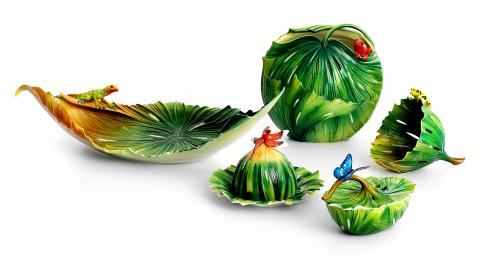Organizers say that more than 400,000 people have visited the Taipei World Design Expo at the Songshan Cultural and Creative Park (松山文創園區) since it opened on Sept. 30. Design fans will have a chance to see yet more items when additional exhibits open tomorrow at the Taipei World Trade Center Nangang Exhibition Hall (台北世界貿易中心南港展覽館) and the Taipei World Trade Center (台北世界貿易中心), where they will run until Oct. 30.
Exhibits at the Songshan Cultural and Creative Park focus on Taiwanese design, with subject matter ranging from artwork inspired by the calligraphy of Tong Yang-tze (董陽孜) to concepts for environmentally sustainable architecture. The events at the Taipei World Trade Center and Nangang Exhibition Hall will explore design across different industries created by international companies.
Organizers of the Taipei World Design Expo, including the Taipei City Government and the Taiwan Design Center (台灣創意設計中心), have invested more than NT$10 million to prepare the Nangang Exhibition Hall. Highlights brought in from overseas include a BMW M3 GT2 racecar customized by American artist Jeff Koons.

Photo courtesy of Taiwan Design Center
The Nangang Exhibition Hall will also feature industrial and product design by international corporations that blend Eastern and Western aesthetics to create items that are appealing to a worldwide audience. These companies range from Japan’s Toyota and Muji to Taiwanese fine porcelain maker Franz Collection (法藍瓷). Franz’s display will include the porcelain series Rainforest Little Dwellers, a recipient of the UNESCO Award of Excellence for Handicrafts that features delicately sculpted and painted renditions of rainforest creatures such as butterflies, dragonflies, frogs and lizards.
Part of the Taipei World Design Expo’s goal is to help establish Taiwan’s prowess for original design as manufacturing jobs are lost to China and Southeast Asia. One area at Nangang Exhibition Hall will shine a spotlight on products that are “MIT” (made in Taiwan) or “DIT” (designed in Taiwan), with more than 200 items by Taiwanese companies showcased, along with explanations of their design process. The IF Mode bicycle, for example, was created to attract commuters who might not have considered biking as a feasible alternative to driving or public transportation. The lightweight IF Mode, which has won Eurobike, iF Product Design and Golden Pin awards, features hidden dirt traps and folds up into a sleek, unobtrusive and easy-to-carry bundle.
The Taipei World Trade Center event, where five small studio apartments will be built to give visitors ideas about how they can use design to enhance their daily lives, showcases the work of more than 100 Taiwanese designers.

Most heroes are remembered for the battles they fought. Taiwan’s Black Bat Squadron is remembered for flying into Chinese airspace 838 times between 1953 and 1967, and for the 148 men whose sacrifice bought the intelligence that kept Taiwan secure. Two-thirds of the squadron died carrying out missions most people wouldn’t learn about for another 40 years. The squadron lost 15 aircraft and 148 crew members over those 14 years, making it the deadliest unit in Taiwan’s military history by casualty rate. They flew at night, often at low altitudes, straight into some of the most heavily defended airspace in Asia.

Taiwan’s democracy is at risk. Be very alarmed. This is not a drill. The current constitutional crisis progressed slowly, then suddenly. Political tensions, partisan hostility and emotions are all running high right when cool heads and calm negotiation are most needed. Oxford defines brinkmanship as: “The art or practice of pursuing a dangerous policy to the limits of safety before stopping, especially in politics.” It says the term comes from a quote from a 1956 Cold War interview with then-American Secretary of State John Foster Dulles, when he said: ‘The ability to get to the verge without getting into the war is

Like much in the world today, theater has experienced major disruptions over the six years since COVID-19. The pandemic, the war in Ukraine and social media have created a new normal of geopolitical and information uncertainty, and the performing arts are not immune to these effects. “Ten years ago people wanted to come to the theater to engage with important issues, but now the Internet allows them to engage with those issues powerfully and immediately,” said Faith Tan, programming director of the Esplanade in Singapore, speaking last week in Japan. “One reaction to unpredictability has been a renewed emphasis on

Beijing’s ironic, abusive tantrums aimed at Japan since Japanese Prime Minister Sanae Takaichi publicly stated that a Taiwan contingency would be an existential crisis for Japan, have revealed for all the world to see that the People’s Republic of China (PRC) lusts after Okinawa. We all owe Takaichi a debt of thanks for getting the PRC to make that public. The PRC and its netizens, taking their cue from the Chinese Communist Party (CCP), are presenting Okinawa by mirroring the claims about Taiwan. Official PRC propaganda organs began to wax lyrical about Okinawa’s “unsettled status” beginning last month. A Global